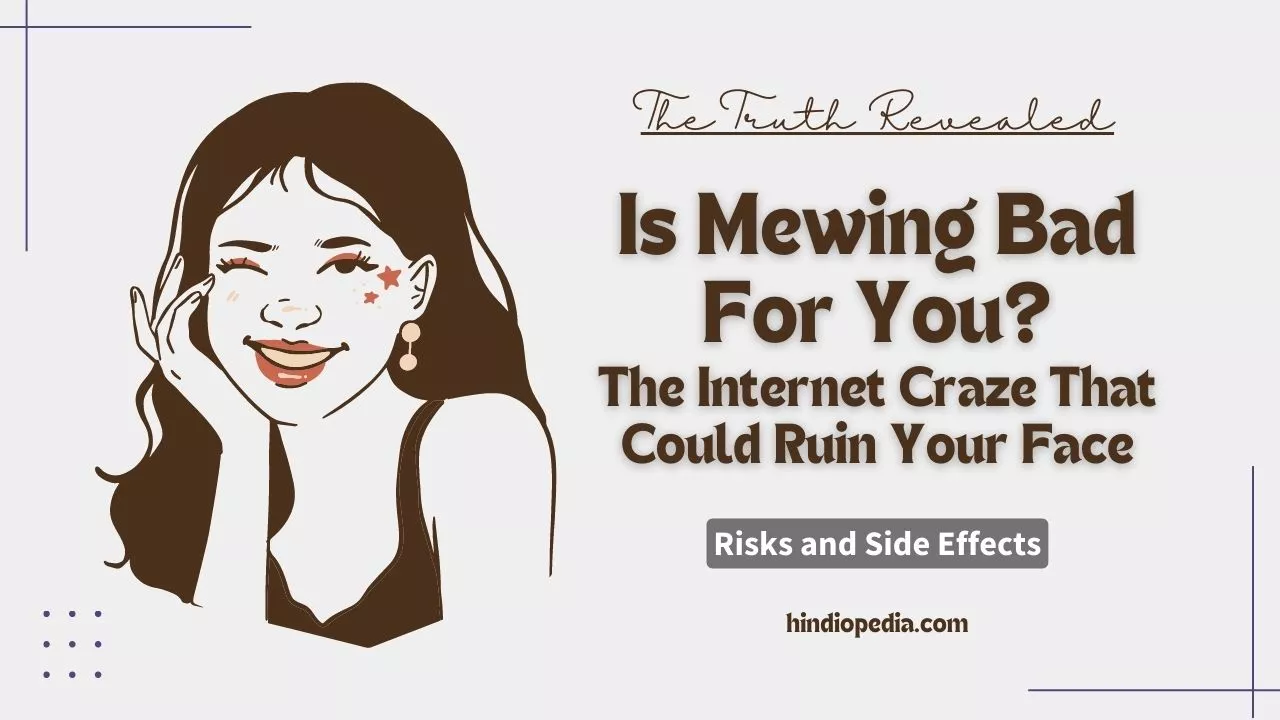Is Mewing Bad For You? The Internet Craze That Could Ruin Your Face
If you have been browsing social media lately you may have come across a term called “mewing“.
Mewing is a technique that involves placing your tongue on the roof of your mouth, closing your lips, and setting your teeth together.
Some people claim that mewing can reshape your jawline and face over time and improve your appearance.
But is mewing really effective? And more importantly, is mewing bad for you?
In this blog post, we will explore what mewing is, where it came from, what research says about it and what are the potential risks and benefits of mewing.
By the end of this post, you will have a better understanding of whether mewing is something you should try or avoid.
What is Mewing?
Mewing is a technique that uses the placement of the tongue to shape the jawline and face. It involves placing your tongue on the roof of your mouth, closing your lips, and setting your teeth together.
Mewing is an internet craze that has received a lot of attention on social media, but there is currently no scientific evidence to support it.
Who Invented Mewing?
The inventor of mewing is Dr. John Mew who developed the technique in the 1900s.
He was the first to discover the impact that the tongue can have on facial structure and developed a method called “orthotropics” to correct facial structure.
Dr. Mew’s son, Dr. Mike Mew, has become the leading advocate for mewing in recent years and has popularized it on social media.
What does Research say about Mewing?
Currently, there is no scientific evidence to prove that mewing is an effective technique for reshaping the face.
Most of the claims about mewing are based on anecdotal reports or personal testimonies which are not reliable sources of information.
Also, mewing has not been tested in any rigorous or peer-reviewed studies, and there is no consensus among experts on its validity or safety.
Mewing may have some benefits for improving oral posture and breathing habits, but it is not a substitute for professional medical or dental advice.
What are some Benefits of Mewing?
Some of the benefits of mewing that people claim include the following:
- Better facial appearance: Mewing can make your jaw stronger, your cheekbones more defined and your face more symmetrical.
- More muscular facial structure: Mewing can increase the tone and strength of your facial muscles.
- Improved profile look: Mewing can lift your chin and nose and reduce any double chin or sagging skin.
- Overall appeal: Mewing can enhance your attractiveness and confidence by improving your facial harmony.
- Improved photogenic qualities: Mewing can make you look better in photos by creating a more flattering angle for your face.
- Boosted lower face shape and alignment: Mewing can align your teeth and jaw and prevent or correct any crookedness or crowding.
- Improved swallowing: Mewing can teach you how to swallow properly without using your cheeks or lips, which can improve your digestion and oral health.
- Resolved breathing and speech problems: Mewing can open up your airway and improve your nasal breathing, which can reduce snoring, sleep apnea, sinusitis, and speech disorders.
Potential Risks of Mewing
Some of the potential risks of mewing that people report are:
- Soreness or numbness: Mewing can cause your tongue, jaw, cheeks, teeth, palate, or gums to feel sore or numb from the pressure or friction.
- Headache: Mewing can cause a headache from the tension in your facial muscles or nerves.
- Loose or crooked teeth: Mewing can damage your teeth by grinding them or shifting them out of alignment. This can affect your bite and oral health.
- Raised nose bridge: Mewing can change the shape of your nose by raising the bridge or making it more prominent. This can alter your facial balance and harmony.
- Psychological distress: Mewing can lead to an unhealthy obsession with your tongue posture and facial appearance, which can cause anxiety, depression, or body dysmorphia.
Apart from these, mewing can have other negative effects such as worsening existing conditions like TMJ disorder, sleep apnea or sinusitis; interfering with normal speech, swallowing or breathing; causing pain in the neck, ears or eyes; or creating facial asymmetry.
Is Mewing Bad For You?
Mewing can be bad for you when done incorrectly or with too much force.
It can cause physical and dental risks such as pain, headaches, facial asymmetry, loose teeth, TMJ disorder, wrinkles and sagging skin.
It can also lead to psychological distress such as obsession, anxiety or body dysmorphia.
Hard Mewing Results
Hard mewing is a technique of applying more pressure with your tongue against your palate to change the shape of your face and jawline.
Some people claim that hard mewing can give faster results than regular mewing.
However, hard mewing is not recommended by most experts as it can have negative side effects such as facial asymmetry, teeth damage, and pain.
There is also no scientific evidence that hard mewing works or is safe.
Is Mewing Supposed to Hurt?
No, mewing is not supposed to hurt.
Also, it should not cause any pain or discomfort if you are doing it correctly.
Some people may experience pain when they mew for various reasons.
Some possible causes are:
If you feel any pain when you mew, you should stop and check your technique.
Make sure you are not clenching, pressing too hard, or using the wrong part of your tongue.
Can Mewing Cause TMJ Disorder?
TMJ stands for temporomandibular joint, which is the hinge that connects your jaw to your skull.
TMJ disorder (TMD) is a condition that causes pain, stiffness, clicking or locking of the jaw.
There is no definitive answer to whether mewing can cause TMJ disorder.
Some sources claim that mewing can help reduce TMJ symptoms by improving your facial alignment and posture.
However, other sources warn that mewing can worsen TMJ disorder by causing clenching, bruxism (teeth grinding), or imbalance in the facial structure.
The Bottom Line
Mewing is not a proven or safe technique for reshaping your face and it has no scientific evidence to support its claims.
If you want to improve your facial appearance or health, you should consult a professional medical or dental provider instead of relying on mewing.
Frequently Asked Questions
There is no scientific evidence to prove that mewing works. It is an internet craze that has not been tested or verified by any studies.
Some people claim that mewing can get you a jawline by reshaping your face and improving your alignment. However, there is no scientific evidence to support this claim.
Some people say that mewing can have health benefits such as reducing the risk of sleep apnea, increasing blood flow, reducing stress, and improving breathing. However, these benefits are not proven by any scientific studies. Mewing is an unproven technique that may or may not work for different individuals.
Mewing is a technique that some people claim can reshape the face by placing the tongue on the roof of the mouth. However, there is no scientific evidence to prove that mewing can reshape the face. The effectiveness of mewing may depend on various factors such as age, genetics, and frequency of practice.
Some possible negatives of mewing are soreness, numbness, headache, loose or crooked teeth, raised nose bridge, psychological distress, and facial asymmetry.




